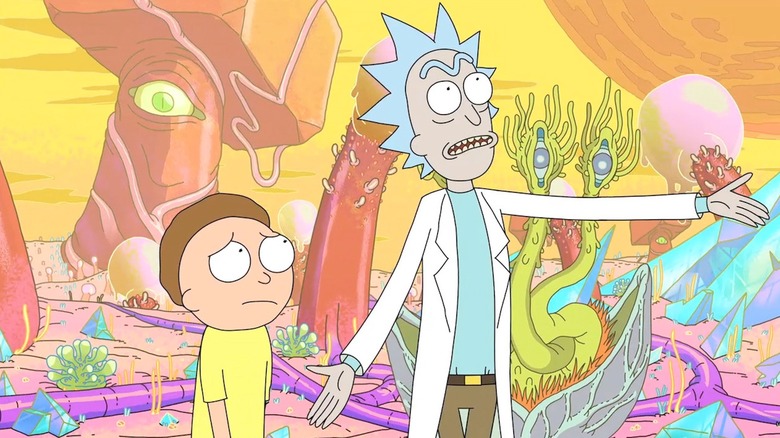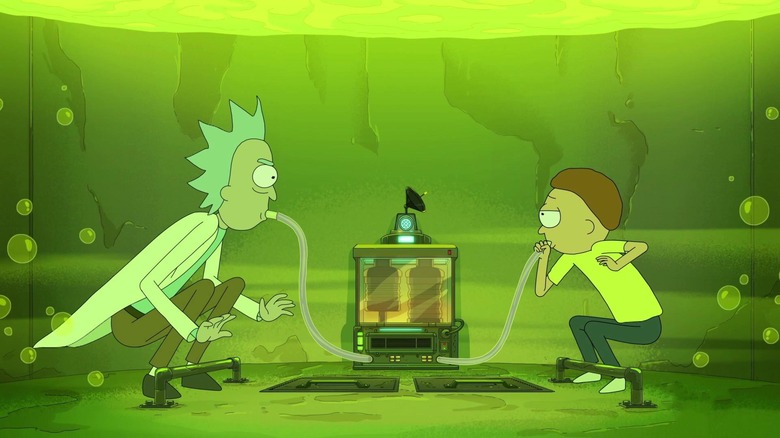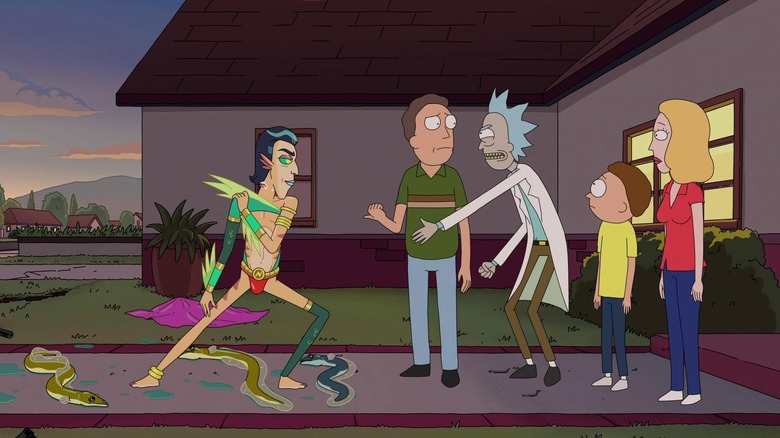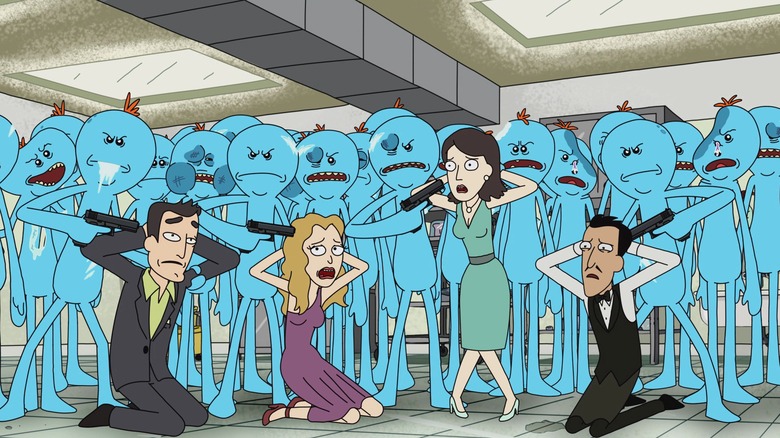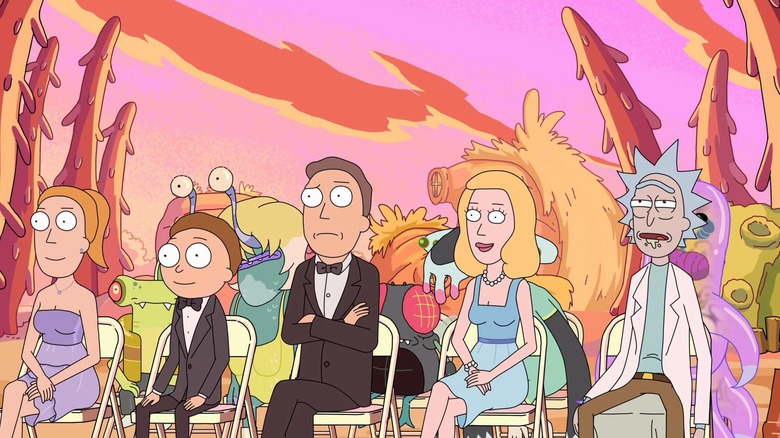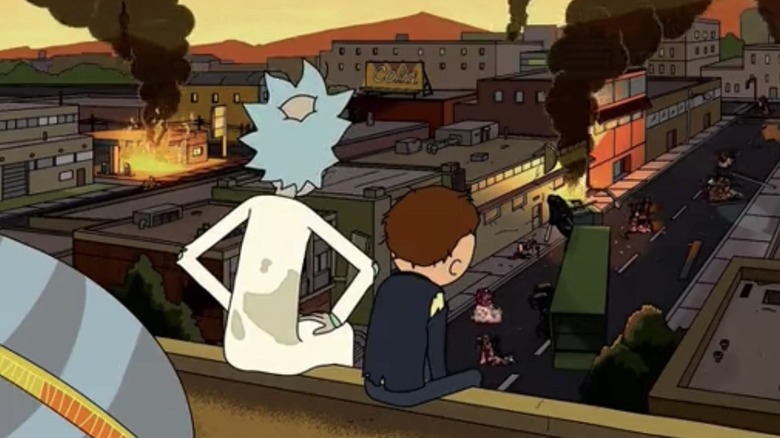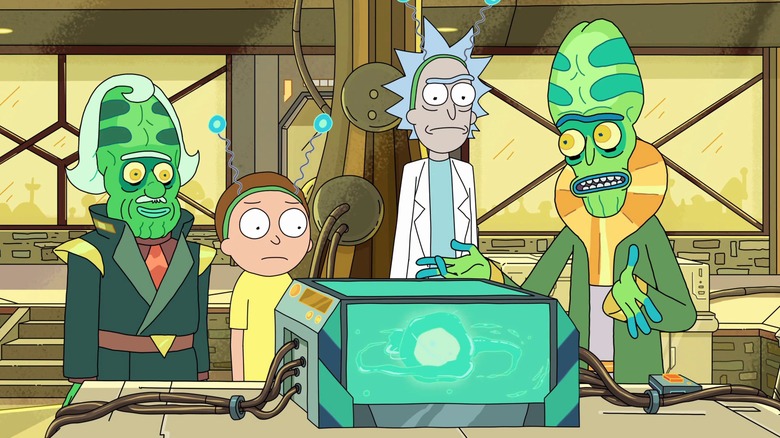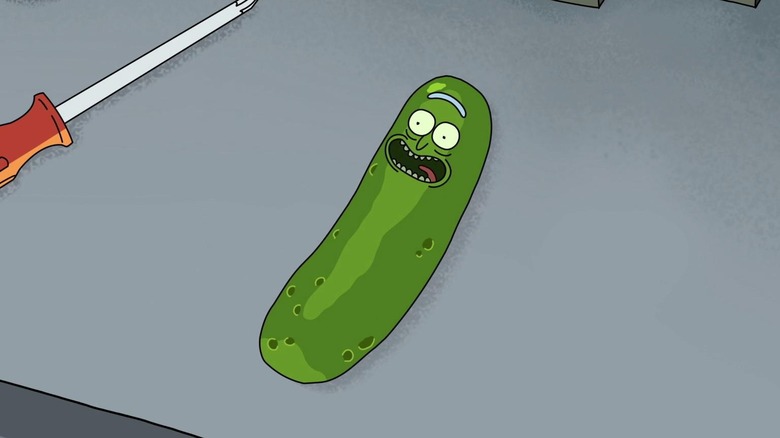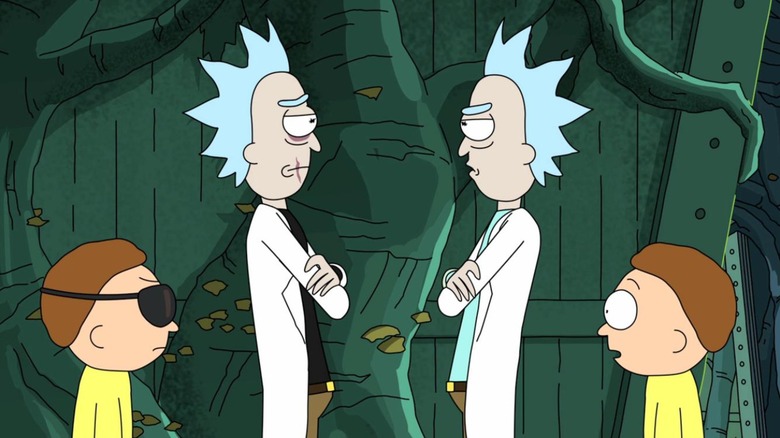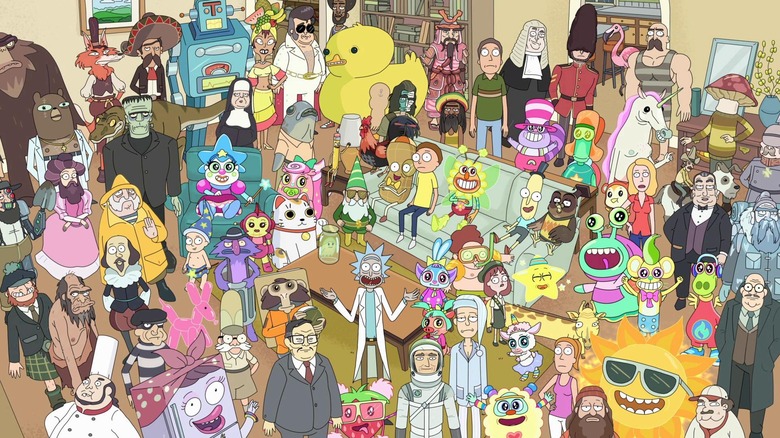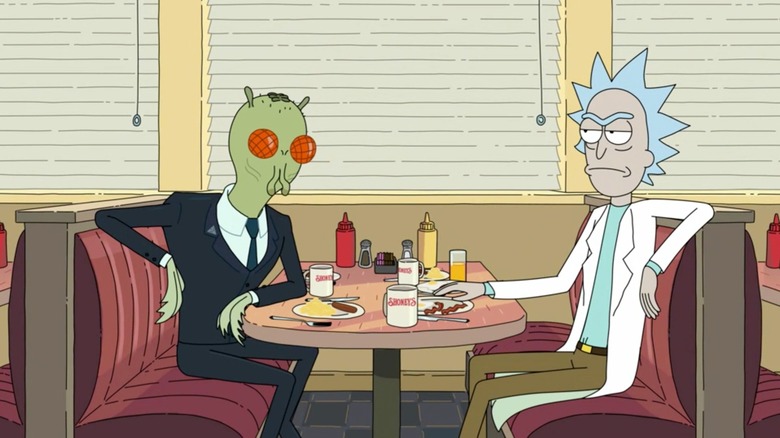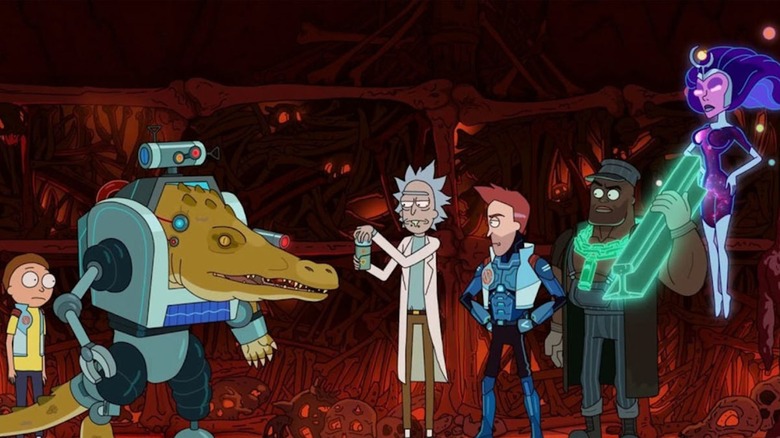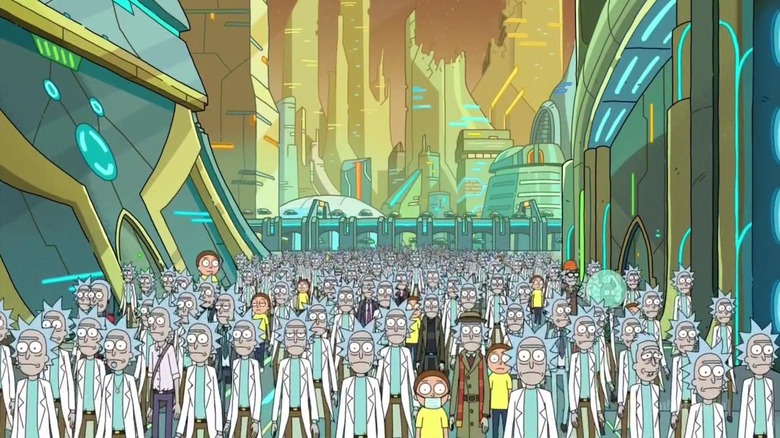12 Best Rick And Morty Episodes Ranked
Since debuting in December 2013, "Rick and Morty" has been a worldwide cultural phenomenon. The series has permeated nearly every layer of popular culture, and despite it taking a long time for each new season to hit the airwaves, fans continue to tune into the hit series. The show lost and had to re-cast the voice of Rick and Morty, Justin Roiland, but thanks to the show's consistently excellent quality, it remains a ratings juggernaut for Adult Swim.
"Rick and Morty's" continuity involves a complex and vast storyline, though it does feature non-serialized episodes as well. The series' self-deprecating humor and meta-commentary makes "Rick and Morty" relatively unique; across its first seven seasons, there have been some exceptional episodes dealing with everything from multiple dimensions and aliens to family relationships and the nature of the human condition.
The best "Rick and Morty" episodes can be determined via their IMDb scores, but ranking them can be subjective. To further nail down the 12 best of the 71 episodes released to date, we combined their IMDb and Rotten Tomatoes scores, aggregating them to find the best of the best. These are the greatest episodes the talented writers, animators, and voice cast of "Rick and Morty" produced in its first seven seasons.
12. Season 4, Episode 8: The Vat of Acid Episode
"The Vat of Acid Episode" features two storylines: one centered around Rick's plan to escape from gangsters by hiding in a fake vat of acid and a Morty solo adventure. The acid is safe, and Rick's plan is detailed, but Morty is unimpressed with it. Rick's need to be seen as brilliant leads him to give Morty a "save point" device that allows Morty to die and return to a previously saved point in time.
In an extended segment, Morty abuses the save point button until he meets a girl. They survive a plane crash together, and Morty chooses not to return to his save point, as that would take him back to before the two met and fell in love. After they're rescued, Jerry (Chris Parnell) accidentally presses the button, undoing Morty's relationship and plunging him into a state of despair. When he learns that the save point didn't really transport him back in time but instead transferred his consciousness into a Morty from another dimension every time he died, that's when things really get complicated.
It's an interesting and clever story that demonstrates Rick's nihilism to the Nth degree, and it's unusually serious. Most "Rick and Morty" episodes feature tons of comedy, but "The Vat of Acid Episode" is different in that it teaches Morty a lesson without trying to make the audience laugh. This proved fruitful, as the episode won the Primetime Emmy Award for outstanding animated program in 2020.
11. Season 5, Episode 1: Mort Dinner Rick Andre
"Mort Dinner Rick Andre" kicks off "Rick and Morty's" fifth season with some interesting character development for Jessica. It begins with Rick and Morty plummeting to Earth as their spaceship falls apart around them. With Rick unconscious and nothing to lose, Morty calls Jessica (Kari Wahlgren) to tell her how he feels about her, and she asks to come over and watch a movie. This leads to Morty becoming determined to live, and he successfully steers their craft safely into the ocean.
When Rick comes to, he freaks out and reveals that he'd entered the domain of his longtime nemesis, Mr. Nimbus (Dan Harmon), who controls the ocean (and police). Mr. Nimbus demands a dinner with Rick, and while that's happening, he throws bottles of wine into a portal to quickly age them. Morty retrieves the bottles, but time moves so quickly on the other side that entire generations pass between each visit.
As Rick deals with his nemesis, Morty's actions on the other side of the portal lead the society there to develop into a techno-civilization intent on defeating him, and they capture Jessica. This upends Morty's plans for their date and she decides it would be best if they remain friends. The self-contained episode avoided addressing the previous season's cliffhanger and offered an incredibly original story that easily stands on its own.
10. Season 1, Episode 5: Meeseeks and Destroy
"Meeseeks and Destro" features two primary, concurrent stories that both offer significant character development for everyone involved. After Beth (Sarah Chalke), Summer (Spencer Grammer), and Jerry irritate Rick, he gives them a Meeseeks box and shows them how to use it; when the button is pressed, a Mr. Meeseeks (Roiland) appears, joyously accomplishes the requested task, and blinks out of existence.
Summer and Beth have no problem operating the box, despite their high-concept requests, while Jerry simply asks to take two strokes off his golf game. The Meeseeks multiply to try and address Jerry's golf game, but, failing to achieve their goal, they opt to kill him instead. This leads to a violent confrontation in a restaurant, but it ultimately works itself out.
Meanwhile, Rick and Morty travel to a world where a giant terrorizes a village. When the giant accidentally dies, the pair wind up on trial for his murder. They're eventually released, though Morty has an unfortunate and disturbingly infamous encounter with Mr. Jellybean (Tom Kenny), who assaults him in a public restroom. Once the adventure is over, Rick gives Morty a punch card that allows him to choose every tenth adventure. This trope remains throughout the series, and Mr. Meeseeks returns as well, but in background situations despite the fans' love for him.
9. Season 2, Episode 10: The Wedding Squanchers
One of the many "Rick and Morty" tropes is that Rick's backstory is kept secret for most of the series. "The Wedding Squanchers" is one of the earliest serialized storyline episodes that somewhat addresses Rick's past. When he's invited to attend Birdperson's (Harmon) wedding, Rick reluctantly attends and gets wasted early on, a reaction to his utter contempt and disdain for the concept of marriage — though he's mostly sad over losing his friend.
Unfortunately, it turns out that the whole thing is a trap, and Birdperson's new wife, Tammy (Cassie Steele), is revealed to be a deep-cover agent for the Galactic Federation who's hunting down Rick and his allies. This leads to a massive firefight, and, unable to return to Earth as it's been added to the Federation, the Smith family escapes to a new home. Rick finds them a remote world to settle on: Dwarf Terrace-9, otherwise known as Tiny Planet.
Rick eventually gives himself up so the family can return to Earth, and the episode ends with him being incarcerated in a maximum security space prison, having been charged with "everything." This episode revealed several aspects of Rick's former life, including the people with whom he once fought a rebellion and his status as an intergalactic fugitive. It also leaves a lot off the table, demanding fans' attention as additional details trickle out over subsequent seasons.
8. Season 1, Episode 6: Rick Potion #9
Morty is, first and foremost, Rick's sidekick, and he often does what he's told — but that changes in "Rick Potion #9." After getting fed up with his grandfather, Morty takes a stand and insists Rick help him create a love potion to use on Jessica. Rick does this, informing Morty that there wouldn't be any unfortunate side effects, though he fails to realize that it's flu season, which causes a problem.
The concoction works, and Jessica becomes devoted to Morty — but then she sneezes, spreading her love for him like a literal plague. Before long, the entire world becomes enamored with Morty, and each time he asks Rick to fix it, the mad scientist nonchalantly comes up with a solution that makes things worse. First, people morph into giant praying mantis monsters, and when Rick tries to repair this, they become what Rick calls "Cronenbergs," a reference to famed body horror director David Cronenberg.
As the world devolves into a nightmare of mutated monsters, Rick comes up with a solution he can use only three or four more times. He finds a dimension where the native Rick and Morty have died, and they replace them, writing off the original universe and shifting the show to this new one. This trope is used again in a future episode, utterly cementing Rick's unwavering nonchalance in turning his back on an entire world, including his daughter, perfectly illustrating Rick's nihilistic nature.
7. Season 2: Episode 6: The Ricks Must Be Crazy
"The Ricks Must Be Crazy" explores the theme of the futility of existence, especially when Rick is involved. When his car doesn't start, Rick shrinks himself and Morty into the battery to figure out what's wrong. Here, we learn that Rick's battery contains a "microverse," a tiny universe that powers his car.
While researching the problem, they learn that a scientist named Zeep (Stephen Colbert) inside the microverse has done the same thing (though he calls it a "miniverse"), with his invention somehow messing up Rick's. Rick and Morty travel into the miniverse to analyze it and again find a scientist working on a similar project, so they jump into that battery. This universe hasn't fully developed, however, and is still in a neolithic state.
When Zeep comes to understand his entire existence is meant to power an amoral scientist's car, he attacks Rick, but the two become trapped when the "teenyverse" scientist commits suicide. Eventually, Rick and Zeep are able to move back up through the various verses into the microverse, where Rick beats Zeep senseless. When Rick and Morty return to the regular-sized world, his car starts. Rick explains that had it not, he would have thrown away the battery; Zeep realizes this and thus stops working on his own experiments.
6. Season 3, Episode 3: Pickle Rick
Many episodes of "Rick and Morty" are considered classics, but few have the lasting impact of "Pickle Rick." The simple title gives away much of the plot, as it begins with Rick having inexplicably transformed himself into a pickle. He sets up a means to turn back after the family leaves for therapy, but Beth's intervention and several near-death experiences push Pickle Rick to overcome some significant obstacles in the form of rats and a gang of Russians he stumbles upon by escaping through a toilet.
Crafting arms and legs out of critter parts, Rick gains mobility and some serious parkour skills, which he uses to systematically kill one Russian after another. This leads to the introduction of Jaguar (Danny Trejo), an incarcerated man coerced into killing Pickle Rick to get his daughter back. Rick and Jaguar come to an understanding, and he escapes, finally attending a therapy session with his family.
Rick admits to transforming himself into a pickle to avoid therapy, offering another glimpse into his psyche. Showrunner Dan Harmon compared "Pickle Rick" to the 'RV breaks down in the desert episode of "Breaking Bad," and it earned "Rick and Morty" its first Primetime Emmy Award for outstanding animated program. It clearly had an impact, as Pickle Rick merchandise remains popular among fans.
5. Season 1, Episode 10: Close Rick-Counters of the Rick Kind
Season 1 establishes little of Rick's backstory, but it does offer some glimpses in "Close Rick-Counters of the Rick Kind." The episode begins with evil versions of Rick and Morty killing another Rick and kidnapping his Morty. Soon after, members of the Council of Ricks enter the Smith home during breakfast through a portal and arrest our Rick. They bring his Morty to the Citadel of Ricks, an interdimensional hub of Ricks and Mortys that our Rick, designated Rick C-137, utterly disdains.
Rick's portal gun history implicates him in the murder of several other Ricks, so he and Morty escape through various dimensional portals. Meanwhile, the Ricks take over the Smith home, setting it up as a basecamp to try and capture C-137. When Rick and Morty investigate who is truly committing the killings, they discover an evil Rick who is hiding himself via the continuous torture of hundreds of Mortys. This establishes the concept of "Morty camouflage," which conceals Rick's activities.
Morty becomes "The One True Morty," and they defeat evil Rick, but in the end, it's revealed that the eyepatch-wearing Morty is the true villain. The episode offers a glimpse into Rick C-137's past, showing him around an infant Morty, which goes against his presumptive backstory of being an absentee father and grandfather. It also sets up several future episodes that revolve around Rick's true place in the multiverse.
4. Season 2, Episode 4: Total Rickall
"Total Rickall" begins with Rick killing Jerry's brother, who turns out to be an alien parasite. It was part of a race that controls memories, worming their way into people's lives, and wanting nothing more than to infest new worlds. Rick keeps them contained behind the house's shield security system, and the episode sees one zany character appear after the other, beginning with longtime family friend Mr. Poopybutthole (Roiland) — who the audience has never heard of before this appearance. Rick tries to contain the situation, but every mention of a memory introduces another wacky character, exponentially worsening the infestation.
"Total Rickall" is a clip show featuring clips the audience has never seen, a recurring trope in showrunner Dan Harmon's playbook. As the problem worsens and the parasites try to compel Rick to open the shields, it dawns on Morty that the only memories of the parasites are good. At the same time, he has numerous terrible memories of his family. This leads him to identify the solution to their situation: anyone the Smiths have only good memories of is a parasite, so they start blasting.
They clean out the house, and Rick removes the shields, but Beth shoots Mr. Poopybutthole, significantly wounding him. He slowly recovers, but the incident traumatizes Beth and widens the gap between the Smiths and their friend.
3. Season 3, Episode 1: The Rickshank Rickdemption
"The Rickshank Rickdemption" kicks off Season 3, picking up after the events of Season 2's cliffhanger, with Rick incarcerated in Galactic Federation prison. Rick finds himself inside his own mind, sitting in a Shoney's, as he's interrogated by Cornvelious Daniel (Nathan Fillion), who's trying to uncover the secret of Rick's portal gun. Meanwhile, the Smiths are coping with the loss of Rick in a world run by the Federation, and the kids aren't doing well.
They hatch a plan to rescue Rick, but Rick is already working on his own means of escape. He takes Daniel through his memories, revealing his backstory and how he invented portal travel. In reality, however, he's creating a virus that gives him full control over the brainalyzer machine, and he takes over Daniel's body. He then jumps from one body to another until he manages to teleport the Citadel of Ricks on top of the Federation prison. He also changes the value of the Federation's currency to zero.
This destroys the Federation, and by the end of the episode, everything is pretty much back to normal. Rick's true motive wasn't to destroy the Citadel or the Federation, as these were only a means of getting rid of Jerry, who separates from Beth after Rick returns home. It's eventually revealed that Rick's backstory presented in the episode is accurate, despite his insistence that it's not.
2. Season 3, Episode 4: Vindicators 3: The Return of Worldender
"Vindicators 3: The Return of Worldender" features a Morty-helmed adventure that begins with a call to action by the Vindicators, a previously unseen group of adventurers. Rick isn't interested in working with them, saying he'd already done so in the past, and he wants to move on. Morty, on the other hand, sees the Vindicators as heroes, and he insists they participate, so Rick begrudgingly agrees.
The Vindicators are on a mission to defeat Worldender, but Rick barely gives them the time of day, opting instead to get wasted and make a literal mess of things. When the team goes to Worldender's hideout, it's revealed that a drunken Rick already defeated Worldender and set up a bunch of lethal traps in the style of the "Saw" franchise to prove the Vindicators are nothing more than interchangeable hype. Morty solves the traps, leading to a confrontation between the remaining Vindicators and Rick and Morty.
The best thing about this episode is that there are numerous references to previous Vindicator team-ups, even though they never occurred in the show. The point is that their activities with the group are meaningless to Rick, though Oni Press later released "Rick and Morty Presents: The Vindicators" comics to fill in some gaps. Additionally, a prequel of shorts called "Vindicators 2: Last Stand Between Earth and Doom" dropped in 2022 and showcased some of the group's activities.
1. Season 3, Episode 7: The Ricklantis Mixup
"The Ricklantis Mixup" is a self-contained Season 3 episode that doesn't feature much of either Rick or Morty, though there are plenty of Ricks and Mortys on display. When the main duo heads offscreen for an adventure in Atlantis, the audience is treated to several vignettes showcasing what happened to the Citadel of Ricks after Rick C-137 merged it with the Federation prison.
The Citadel remains standing, but society there has devolved as Mortys kill Mortys and Ricks kill Ricks amidst the backdrop of a democratic election. There are numerous pop culture references throughout the episode, including one major "Stand By Me" homage. Primarily, though, the action focuses on a Morty cop teaming up with a Rick, and their adventure shows the futility of their existence and the Citadel as a whole. Meanwhile, evil Morty runs for president and wins, taking control for his nefarious purposes — which aren't revealed until the end of Season 5. Much of the episode deals with the nature of existence, a common "Rick and Morty" theme.
The episode won the 2018 Annie Award for outstanding achievement in writing, which it absolutely deserved. "The Ricklantis Mixup" strays from the typical episode structure by eschewing the standard characters for others we never met before outside of Evil Morty. Despite this, the show's lore developed without its main characters — an impressive achievement resulting in the series' best episode to date.
